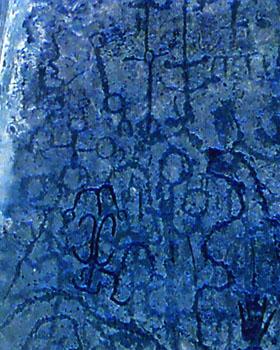
The Picket Wire Canyon People Reveal Themselves A special announcement by Dan Eden for ViewZone.
In the two years since this story was published (The Picketwire Canyon People) we have had a few very good theories. The first attempts were made utilizing the translation techniques of LaVan Martineau. This seemed helpful in making out the meanings of some symbols, but it did not provide any literal translation. There was no way for two people to come up with the same exact message. Another script that had several of the same symbols was found belonging to the Incas. This script was the only one to contain the curious rows of dots, seen in the Picketwire Canyon. Bill McGlone was an adherent to the scientific method. He was always careful not to make any statements that were not based on proof. But he did make it known that he had found a strong similarity between this type of rock-writing and one used about 2000 years ago in the Middle East. It was called Thamudic. Many of the symbols are identical to Thamudic. Many more are similar but rotated. There were too many enigmas that prevented any firm confirmation, and not a promise of a translation. What Bill McGlone would have wanted was a repeatable and coherent translation of the many different symbol groups. It appears that one has finally been found. |
 Dr. James Harris and Dan Honne have appaently cracked the code of the Thamudic-like script. They discovered an earlier version whose 22 letter alphabet system matches the symbols in Colorado. The translations, because of their content, further support the possible migration of a Middle-East culture to North America. And this all seems to have happened at a time when the New World was not yet "discovered" by Europeans.
Dr. James Harris and Dan Honne have appaently cracked the code of the Thamudic-like script. They discovered an earlier version whose 22 letter alphabet system matches the symbols in Colorado. The translations, because of their content, further support the possible migration of a Middle-East culture to North America. And this all seems to have happened at a time when the New World was not yet "discovered" by Europeans.The script used to translate the petroglyphs is called Old Negev, after the desert location in Israel where similar petroglyphs were found. History puts the language in use at about 600 BC in the Sinai, and dating techniques confer a similar age on the Colorado petroglyphs. The translations that Dr. Harris provides confirm not only the similarities of the alphabets used, but of a similar religion and culture. At least that's what any reasonable person would concede. In his book, The Name of God, Harris focuses special attention on the Anasazi, and their ancestral tribes. He finds Old Negev incorporated into artistic designs (like on pottery or sculpture) of Olmec and Central American cultures, spelling out the name of their God. Until now these Old Negev symbols were considered stylistic decorations. Harris sites many examples of Old Negev throughout the American Southwest and traces the remnants and migrations of this once rich culture. What happened to the "Picketwire Canyon People" will surely surprise you as Harris' discovery will deeply effect your view of human history. Dr. James Harris has almost 20 of the Colorado symbol groups translated. He has allowed Viewzone to document this important and unexpected evidence. In publishing these translations, we hope that we can stimulate some serious inquiry of our collective, human origins. We welcome your comments and ideas. A complete review of his book, The Name of God will also accompany Dr. Harris' Colorado translations in out next issue. |

 In 1998, Viewzone sent a crew to Colorado to investigate reports of non-Native American signs and symbols that were pecked into the rock faces along miles of steep canyons. The researcher, Bill McGlone, spent his retirement methodically documenting these ancient petroglyphs.
In 1998, Viewzone sent a crew to Colorado to investigate reports of non-Native American signs and symbols that were pecked into the rock faces along miles of steep canyons. The researcher, Bill McGlone, spent his retirement methodically documenting these ancient petroglyphs.